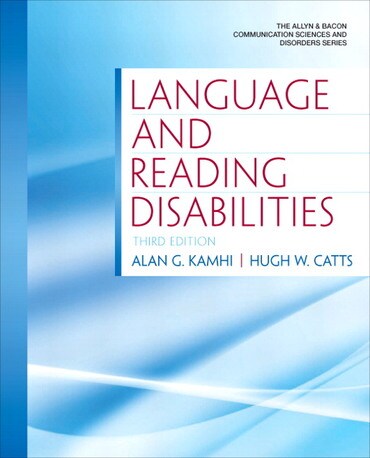
- Alan G. Kamhi |
- Hugh W. Catts |
Title overview
-
Contributions from leading researchers provide an up-to-date perspective from experts in the field.
-
A unique research-based classification system helps readers understand language and reading disabilities, as well as the best techniques available to treat students with these special needs.
-
Numerous suggestions for intervention present research that is easy-to-translate into clinical practice.
-
A chapter on reading development (Chapter 2) focuses on the importance of early exposure to literacy, compares stage theories of reading development to current self-teaching mechanisms, and tackles the development of reading comprehension.
New To This Edition:
· A new chapter on reading comprehension (Chapter 6) tackles definitional issues that affect the way reading is assessed and taught. Additionally, a model of comprehension is presented to help readers develop appropriate measures of understanding.
· A new chapter on spelling (Chapter 8) covers the innovative 4-block model of spelling while also providing numerous suggestions to help readers assess and treat students with spelling difficulties.
· Consolidated information on defining and classifying reading disabilities (Chapter 3) streamlines content to make the text even more accessible.
· Fully revised to include updates such as:
A new section on comprehension development (Chapter 2)
New information about RTI and subgroups of poor readers (Chapter 3)
New information about auditory processing deficits and poor comprehenders (Chapter 4)
A new section about RTI and poor responders (Chapter 5)
New information about developing literate vocabulary and complex syntactic structures (Chapter 7)
Additional information about how to write genre specific texts (Chapter 9)
New information on cognitive linguistic skills in writing (Chapter 10).
Table of contents
-
Preface
-
Acknowledgments
-
Contributors and Affiliations
-
CHAPTER 1: Language and Reading: Convergences and Divergences
- CHAPTER 3: Defining and Classifying Reading Disabilities
- CHAPTER 4: Causes of Reading Disabilities
- CHAPTER 5: Assessment and Instruction for Phonemic Awareness and Word Recognition Skills
- CHAPTER 6: Perspectives on Assessing and Improving Reading Comprehension
-
CHAPTER 7: Assessing and Remediating Text Comprehension Problems
- CHAPTER 8: Spelling Assessment and Intervention: A Multiple Linguistic Approach to Improving Literacy Outcomes
- CHAPTER 9: Learning to Write
-
CHAPTER 10: Developing Knowledge and Skills for Writing
-
Appendix 10.1
-
References
-
Index
Author bios
Author Bio
Alan G. Kamhi, Ph.D.
Department of Communication
University of North Carolina at
Greensboro, Greensboro, NC
Hugh W. Catts, Ph.D.
Department of Speech-Language-
Hearing: Sciences and Disorders
University of Kansas, Lawrence, KS
Contributors
Cheryl M. Scott, Ph.D.
Department of Communication Disorders
Rush University Medical Center,
Chicago, IL
Carol E. Westby, Ph.D.
Research Center for Family and Community
Albuquerque, NM
Stephanie Al Otaiba, Ph. D.
Florida State University
Tallahassee, FL
Marcia L. Kosanovich Ph. D.
Florida Center for Reading Research
Tallahassee, FL
Joe K. Torgesen, PhD.
Florida Center for Reading Research
Florida State University,
Tallahassee, FL
Suzanne L. Adlof, Ph.D.
University of Kansas
Department of Speech-Language-Hearing: Sciences and Disorders,
Lawrence, Kansas
Kenn Apel, PhD; Danielle Brimo, M.A.
School of Communication Science and Disorders,
The Florida State University,
Tallahassee, FL
Julie Masterson, PhD
Communication Sciences and Disorders
Missouri State University,
Springfield, MO